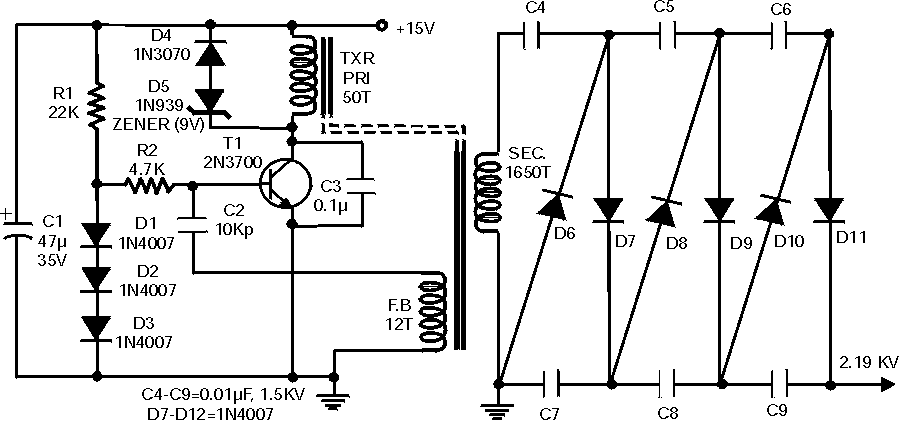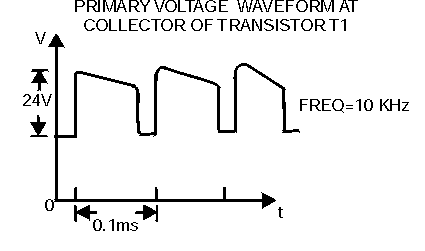The simple circuit described here is capable of generating up to 2.1 kilovolts or more from a current source with low voltage flyback (LOPT) transformer to recover from a B / W or color TV or computer monitor. Typical output with a 12 VDC 2 A power supply or batteries will be 12,000 V. Maximum output current at full voltage is typically on the order of 1 to 2 mA. Higher currents are available, but decreases the output voltage. A 2 kV, more than 10 mA may be possible depending on your particular flyback transformer input voltage and current.

As you can see the diagram below, does not get much easier than this!

CAUTION: Read the document: “Safety Guidelines for High Voltage and / or equipment for power line” and shoot the circuit!
Read in its entirety!
flyback obtain solutions with high voltage secondary winding. Primary may be left intact if it is known to be in good condition – not short-circuited. A flyback removed due to failure can be used if the primary were to fail and the primary turns can be removed without damaging the HV secondary or losing the secondary connection back! Flyback fail in both directions (primary and secondary).
CAUTION: Locate the return of the winding tension. It can be a different color yarn winding low voltage or the output of the flyback portion of the plate in a different place. You can not use an ohmmeter to locate the return of power Fast-forward if the return to a high-voltage multiplier or HV rectifier diodes rectifiers decline is far greater than the battery voltage used in your meter. However, a connection with a liquidation infinite resistance to all other terminals may be the HV return. The flyback HV rectifier or multiplier without a return can be easily identified by measuring the resistance between the HV output and all other terminals. The high voltage winding has a resistance of 100s-1000 ohms than a single dose of digits or less for all other windings.
Wind 10 turn center tapped winding drive and 4 turn centertapped feedback winding using # 16-20 gauge wire. Make sure that both halves of each coil are wound in the same direction. A good insulation with duct tape.
Vcc should typically be in the range 12-24 volts in a couple of amps. Oscillating circuit is scheduled for about a Vcc of 5 V or more. If you do not get the high voltage, reverse the connections to the transistor bases. Heat sink is recommended for the transistor. Be aware of the capabilities of your return (B / W monitor up to 15 KV, color up to 30 KV). You risk destroying the secondary windings and / or HV rectifier if you get carried away. Running this on 24 volts will probably cause an internal arc-over in a small flyback, then start again with more caution and a new flyback.
Actual production depends on the turnover of the flyback you have.
For a typical small B / W TV, monochrome screen or a video terminal, you should be able to get around 12,000 volts with 12 VDC.
I built one from a dead Mac-Plus flyback from which I removed the coils (dead) primary.
With a large color television or color monitor flyback, 30,000 V or more will be made possible with 24 VDC.
The operating frequency is in KHz to 10 KHz range depending seconds of VDC, the load and the specific flyback.
You can experiment with the speed, resistance values, etc. to optimize operation and power for your needs.
WARNING: Contact with the output will be painful, but probably not particularly dangerous due to small (few mA) current availability.
HOWEVER, if you add a high voltage capacitor for charge storage, do not even think of approaching the HV!
